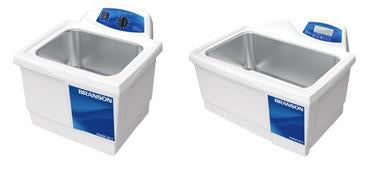Ultrasonic baths typically operate at a single frequency, as do other types of ultrasonic equipment, such as ultrasonic homogenizers. There are some ultrasonic baths available that operate at a range of frequencies, but this feature is unnecessary for most applications.
In this post, we explain how frequency affects ultrasonic cleaning and why you likely don’t need a range of frequencies. We also explain the concept of sweep frequency, which is a common feature of modern ultrasonic baths.
The Effect of Frequency on Cleaning
Ultrasonic cleaning works by a process called cavitation whereby bubbles are formed in the liquid and subsequently collapse, transferring energy and removing surface contaminants. The size of these bubbles depends on the frequency of the ultrasonic waves.
While most ultrasonic baths operate at a frequency between 37–45 kHz, you may come across some that operate at a much lower or higher frequency.

These Bransonic ultrasonic baths operate at a frequency of 40 kHz.
A lower frequency results in the creation of larger cavitation bubbles. When these burst, they implode more vigorously and release a larger amount of energy than smaller bubbles do. As such, low-frequency cleaning is more aggressive and is suitable for harsher cleaning of material that isn’t easily damaged.
High-frequency cleaning involves smaller cavitation bubbles releasing lower levels of energy. This method is less aggressive and more suitable for fine cleaning of delicate materials such as those with polished surfaces. The bubbles are more evenly distributed and can therefore do a more thorough job. Higher frequencies are better for cleaning objects with lots of crevices or seams as the bubbles are more capable of penetrating into tight spaces.
That being said, as mentioned, most ultrasonic baths will have a frequency of 37–45 kHz. A frequency within this range will be suitable for most applications. You would only need a low or high-frequency bath for specialized cleaning. For example, you’d use a high-frequency cleaner for jewelry or electronics.
Sweep Frequency
In slight contradiction to what we’ve stated above, most single-frequency baths aren’t strictly operating at one frequency. Instead, they use a feature called sweep frequency, whereby the driving frequency is continuously varied while remaining close to the center frequency.
For example, if the frequency is 40 kHz, at any given time, the actual frequency could be between 38–42 kHz (with the range being model-dependent).
So after we’ve just told you that precise frequency doesn’t matter all that much, what’s the need for sweep frequency?
Ultrasonic baths have multiple transducers, each of which may have a very slightly different center frequency, due to manufacturing tolerances. For example, in a 40 kHz unit, it’s possible that some, if not all, of the transducers will have a center frequency that is slightly above or below 40 kHz. If the center frequency remained at 40 kHz, there would be one or more transducers that are not maximally excited. Using a sweep frequency, all transducers will be maximally excited (at their center frequency) during the sweep cycle.1
Another effect of sweep frequencies is that more bubbles are produced. This enhances cleaning and speeds up degassing processes.
- Fuchs, J. Ultrasonics – The What and Why of Sweeping Frequency. Cleaning Technologies Group. 2014
